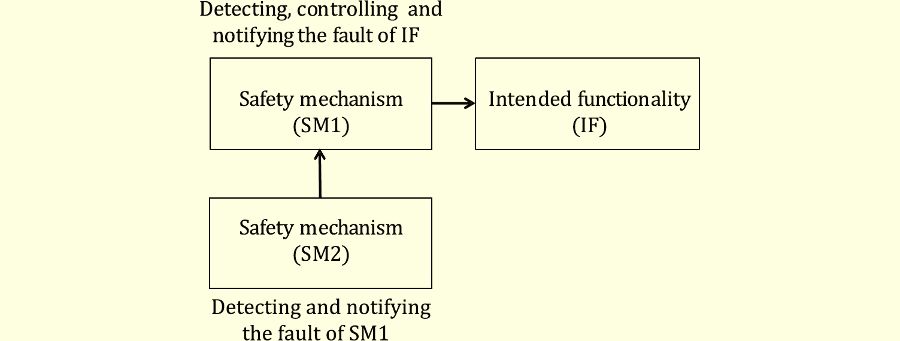 |
27 |
確率コントリビューション (5) |
 |
過剰確率の調整
しかしながら前稿の注※確率調整で示すように、ユニオンエレメントに関して解いて得られたPMHF(488.6)は余分な場合を2パターン含みます。余分な場合とはユニオンが2回フォールトする時、
①IFのフォールトに引き続いてIFがフォールトする
②SM1のフォールトに引き続いてSM1がフォールトする
となる場合が含まれるため、そのPMHFを差し引く必要があるからです。
すると、①のPMHFは(489.5)であり、 $$ M_\text{PMHF,DPF,IF⇒IF}= \frac{K_\text{IF,RF}}{2}\lambda_\text{IF}^2[(1-K_\mathrm{DPF})T_\text{lifetime}+K_\mathrm{DPF}\tau] \tag{490.1} $$ また②のPMHFも同様に(489.8)であるため、 $$ M_\text{PMHF,DPF,SM⇒SM}=\frac{K_\text{IF,RF}}{2}\lambda_\text{SM}^2[(1-K_\mathrm{DPF})T_\text{lifetime}+K_\mathrm{DPF}\tau] \tag{490.2} $$ 従って、PMHFのDPF部分は、(488.6)から(490.1)及び(490.2)を差し引いて、 $$ \begin{eqnarray} M_\text{PMHF,DPF}&=&M_{\text{PMHF,DPF,IF}\cup\text{SM}}-M_\text{PMHF,DPF,IF⇒IF}-M_\text{PMHF,DPF,SM⇒SM}\\ &=&[(\lambda_\text{IF}+\lambda_\text{SM})^2-\lambda_\text{IF}^2-\lambda_\text{SM}^2]\frac{K_\text{IF,RF}}{2}[(1-K_\mathrm{DPF})T_\text{lifetime}+K_\mathrm{DPF}\tau]\\ &=&K_\text{IF,RF}\lambda_\text{IF}\lambda_\text{SM}[(1-K_\mathrm{DPF})T_\text{lifetime}+K_\mathrm{DPF}\tau] \end{eqnarray} \tag{490.3} $$ これは過去記事で求めた、(222.9)のPMHF値のDPF項と完全に一致します。このように、得られた方程式に対して別の角度から整合性のある解釈ができることは、大変に面白いだけでなく方程式の妥当性を裏付けるものと考えます。
また、確率コントリビューションの考えから1st editionの式を出発点として、2nd editionの式ではなく、2020年論文の式が導出されることも大変興味深い事実です。
なお、本稿はRAMS 2023に投稿中のため一部を秘匿していますが、論文公開後の2023年2月頃に開示予定です。RAMS 2023が終了したため、秘匿部分を開示します。






